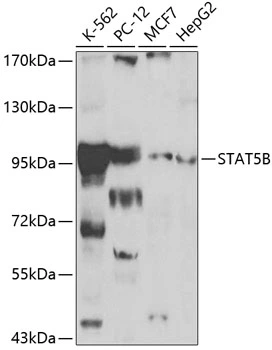![IHC-P analysis of human breast carcinoma tissue section using GTX01153 STAT5B antibody [SD08-08]. IHC-P analysis of human breast carcinoma tissue section using GTX01153 STAT5B antibody [SD08-08].](https://www.genetex.com/upload/website/prouct_img/normal/GTX01153/GTX01153_20200303_IHC-P_599_w_23053121_634.webp)
IHC-P analysis of human breast carcinoma tissue section using GTX01153 STAT5B antibody [SD08-08].
STAT5B antibody [SD08-08]
GTX01153
ApplicationsWestern Blot, ImmunoHistoChemistry, ImmunoHistoChemistry Paraffin
Product group Antibodies
ReactivityHuman, Mouse, Rat
TargetSTAT5B
Overview
- SupplierGeneTex
- Product NameSTAT5B antibody [SD08-08]
- Delivery Days Customer9
- Application Supplier NoteWB: 1:1000-1:2000. IHC-P: 1:50-1:200. *Optimal dilutions/concentrations should be determined by the researcher.Not tested in other applications.
- ApplicationsWestern Blot, ImmunoHistoChemistry, ImmunoHistoChemistry Paraffin
- CertificationResearch Use Only
- ClonalityMonoclonal
- Clone IDSD08-08
- Concentration1 mg/ml
- ConjugateUnconjugated
- Gene ID6777
- Target nameSTAT5B
- Target descriptionsignal transducer and activator of transcription 5B
- Target synonymsGHISID2, STAT5, signal transducer and activator of transcription 5B, transcription factor STAT5B
- HostRabbit
- IsotypeIgG
- Protein IDP51692
- Protein NameSignal transducer and activator of transcription 5B
- Scientific DescriptionThe protein encoded by this gene is a member of the STAT family of transcription factors. In response to cytokines and growth factors, STAT family members are phosphorylated by the receptor associated kinases, and then form homo- or heterodimers that translocate to the cell nucleus where they act as transcription activators. This protein mediates the signal transduction triggered by various cell ligands, such as IL2, IL4, CSF1, and different growth hormones. It has been shown to be involved in diverse biological processes, such as TCR signaling, apoptosis, adult mammary gland development, and sexual dimorphism of liver gene expression. This gene was found to fuse to retinoic acid receptor-alpha (RARA) gene in a small subset of acute promyelocytic leukemias (APLL). The dysregulation of the signaling pathways mediated by this protein may be the cause of the APLL. [provided by RefSeq, Jul 2008]
- ReactivityHuman, Mouse, Rat
- Storage Instruction-20°C or -80°C,2°C to 8°C
- UNSPSC12352203

![IHC-P analysis of mouse colon tissue section using GTX01153 STAT5B antibody [SD08-08]. IHC-P analysis of mouse colon tissue section using GTX01153 STAT5B antibody [SD08-08].](https://www.genetex.com/upload/website/prouct_img/normal/GTX01153/GTX01153_20200303_IHC-P_600_w_23053121_753.webp)
![IHC-P analysis of human spleen tissue section using GTX01153 STAT5B antibody [SD08-08]. IHC-P analysis of human spleen tissue section using GTX01153 STAT5B antibody [SD08-08].](https://www.genetex.com/upload/website/prouct_img/normal/GTX01153/GTX01153_20200303_IHC-P_601_w_23053121_766.webp)
![IHC-P analysis of mouse testis tissue section using GTX01153 STAT5B antibody [SD08-08]. IHC-P analysis of mouse testis tissue section using GTX01153 STAT5B antibody [SD08-08].](https://www.genetex.com/upload/website/prouct_img/normal/GTX01153/GTX01153_20200303_IHC-P_602_w_23053121_306.webp)
![Various whole cell extracts (30 microg) were separated by 7.5% SDS-PAGE, and the membrane was blotted with STAT5B antibody [SD08-08] (GTX01153) diluted at 1:500. The HRP-conjugated anti-rabbit IgG antibody (GTX213110-01) was used to detect the primary antibody. Various whole cell extracts (30 microg) were separated by 7.5% SDS-PAGE, and the membrane was blotted with STAT5B antibody [SD08-08] (GTX01153) diluted at 1:500. The HRP-conjugated anti-rabbit IgG antibody (GTX213110-01) was used to detect the primary antibody.](https://www.genetex.com/upload/website/prouct_img/normal/GTX01153/GTX01153_HJ1017_20200228_WB_w_23053121_523.webp)
![Various whole cell extracts (30 microg) were separated by 7.5% SDS-PAGE, and the membrane was blotted with STAT5B antibody [SD08-08] (GTX01153) diluted at 1:1000. The HRP-conjugated anti-rabbit IgG antibody (GTX213110-01) was used to detect the primary antibody. Various whole cell extracts (30 microg) were separated by 7.5% SDS-PAGE, and the membrane was blotted with STAT5B antibody [SD08-08] (GTX01153) diluted at 1:1000. The HRP-conjugated anti-rabbit IgG antibody (GTX213110-01) was used to detect the primary antibody.](https://www.genetex.com/upload/website/prouct_img/normal/GTX01153/GTX01153_HJ1017_20200821_WB_M_w_23053121_287.webp)
![Various whole cell extracts (30 microg) were separated by 7.5% SDS-PAGE, and the membrane was blotted with STAT5B antibody [SD08-08] (GTX01153) diluted at 1:1000. The HRP-conjugated anti-rabbit IgG antibody (GTX213110-01) was used to detect the primary antibody. Various whole cell extracts (30 microg) were separated by 7.5% SDS-PAGE, and the membrane was blotted with STAT5B antibody [SD08-08] (GTX01153) diluted at 1:1000. The HRP-conjugated anti-rabbit IgG antibody (GTX213110-01) was used to detect the primary antibody.](https://www.genetex.com/upload/website/prouct_img/normal/GTX01153/GTX01153_HJ1017_20200821_WB_R_w_23053121_387.webp)

![WB analysis of HeLa (1), K562 (2), NIH3T3 (3), C6 (4), HEK293 (5), Jurkat (6) and HL-60 (7) cell lysate using GTX82807 STAT5B antibody [5B3].](https://www.genetex.com/upload/website/prouct_img/normal/GTX82807/GTX82807_20170912_WB_w_23051501_514.webp)

![WB analysis of Wild-type (WT) and STAT5B knockout (KO) HeLa cell extracts using GTX08967 STAT5B antibody [GT1160]. Dilution : 1:1000 Loading : 25microg](https://www.genetex.com/upload/website/prouct_img/normal/GTX08967/GTX08967_20200327_WB_1_w_23053123_332.webp)
